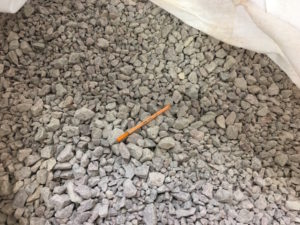You don’t usually think of gravel or aggregates as a resource until you’re trying to make concrete. In many parts of the country, good-quality aggregates for concrete are in short supply. This is especially true in urban areas.
So if it’s difficult to find the aggregates, do you spend a lot of money to ship it in from a long way away, or do you look more closely at nearby aggregates that are maybe less than ideal? How do you tell whether they’re good enough?

Start by hiring a petrographer to determine the “petrographic number” to rate the physical properties of aggregates. Petrography is the science of studying rocks or minerals, especially under a microscope. A petrographer can assign a number that closely ties to its performance in the field. He or she categorizes minerals as good, fair, poor, or deleterious and assigns weighting factors of 1, 3, 6, or 10, respectively.
Numerical rating system for aggregates begins
Rogers (1990) reports that the petrographic number originated in the late 1940s, when two geologists working for the Ontario Department of Highways surveyed concrete pavements in southwestern Ontario. They rated the performance of the aggregates based on popouts, surface scaling, map cracking, and other physically-related defects. They obtained samples of the aggregates from the original sources. In addition to durability tests, they conducted petrographic examinations, identifying excellent, good, fair, and poor varieties of rock based on their performance in pavements.
So when did this rating system begin? Geologists from the Ontario Department of Highways began experimenting with a numerical weighting system for classifying rock varieties in 1950. A sample made up of 100% strong, unweathered basalt would have a petrographic number (PN) of 90. A sample of 100% clay or soft shale would have a petrographic number of 600. The petrographic number became a convenient tool for comparing the quality of aggregates by expressing the relative amounts of good, fair, and poor material in a single number (Rogers, 1990).
Provincial highway contracts used the maximum petrographic number system beginning in 1953. Various modifications and additions included new aggregate sources, based as much as possible on their actual performance in the field. Petrographic examination is an excellent indicator of changes in the quality of existing aggregate sources that can be easily quantified. (Rogers, 1990).
Field performance sets the context
Rogers (1990) notes how critically important field investigation is to petrographic procedure. He added that classification based on observed performance in highways or structures is important.
Aggregates that can be described as hard, medium hard, or surface weathered would generally be rated as “good;” soft, brittle, or deeply weathered aggregates would be rated as “fair;” friable, silty, or clayey components would be rated as “poor,” and clay, chert, or shale would be rated as “deleterious.”
A perfect aggregate comprising only sound, hard constituents would thus have a petrographic number (PN) of 100. Progressively higher PNs indicate the presence of either large amounts of fair constituents or small amounts of deleterious constituents.
Don’t assume a low PN is an indication of an aggregate’s resistance to alkali reactivity. The PN is a measure of its physical quality only. ASTM C1778 provides a detailed protocol for evaluating and mitigating the potential reactivity of aggregates.
Resource: Rogers, Christopher A. “Petrographic Examination of Aggregate and Concrete in Ontario,” Petrography Applied to Concrete and Concrete Aggregates, ASTM STP 1061, Bernard Erlin and David Stark, Editors. Philadelphia, PA: American Society for Testing and Materials, 1990, pp. 5-31.
